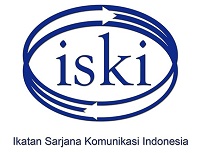Analisis Etnografi Virtual Tentang Proses Komunikasi Kesehatan Ibu dan Anak dalam Whatsapp Group “Tentang Anak”
Abstract
Keywords
Full Text:
PDFReferences
A. Griffin, E. (2003). A First Look at Communication Theory 5th ed. New York: McGraw-Hill.
Antheunis, M.L, Tates, K., & Nieboer, T. E. (2013). Patients’ and health professionals’ use of social media in health care: motives, barriers and expectations. Patient Education and Counseling., 92(3), 426–431.
Bernhardt, J. M., Lariscy, R.A. W., Parrott, R. L., Silk, K. J., & Felter, E. M. (2002). Perceived barriers to Internet-based health communication on human genetics. Journal of Health Communication, 7(4), 325–340.
Chou, WY; Hunt, YM; Moser. Richard P; EB Beckjord; Hesse, B. W. (2009). Social Media Use in the United States: Implications for Health Communication. Journal of Medical Internet Research, 11(4).
Clough, J., Lee, S., & Chae, D. H. (2013). Barriers to health care among Asian immigrants in the United States: a traditional review. Journal of Health Care for the Poor and Underserved, 24(1), 384–403.
Daniel, K. L. (2009). The power of mom in communicating health. American Journal of Public Health, 99(12), 2119.
Hine, C. (2000). Virtual Ethnography. London: Sage Publications. London: Sage Publication.
Jennifer Martin-Biggers, Katrina Beluska, Virginia Quick, M. T. & C. B.-B. (2015). Cover Lines Using Positive, Urgent, Unique Language Entice Moms to Read Health Communications. Journal of Health Communication, 20(7), 766–772.
Park, H., Reber, B. H., & Chon, M. G. (2016). Tweeting as health communication: health organizations’ use of Twitter for health promotion and public engagement. Journal of Health Communication, 21(2), 188–198.
Porter, N., & Ispa, J. M. (2013). Mothers’ online message board questions about parenting infants and toddlers. Journal of Advanced Nursing, 69(3), 559–568.
Setiawan, Erik; Desiana, Fauzi I; Wulandari, Widi; Salsabila, I. (2017). Makna Hijrah pada Mahasiswa Fikom Unisba di Komunitas (‘followers’) Akun “LINE@DakwahIslam.” Mediator Fikom Unisba, 1(Juni).
Tong & Walther, J. B. (2011). Just say “No thanks”: Romantic rejection in computer-mediated communication. Journal of Social and Personal Relationships, 28, 488–506.
Walther, J. B. (2011). Theories of computer-mediated communication and interpersonal relations. The handbook of interpersonal communication (Vol. 4, pp. 443–479).
Wright, K. B., & Bell, S. B. (2003). Health-related support groups on the Internet: Linking empirical findings to social support and computer-mediated communication theory. Journal of Health Psychology, 8(1), 39-54., 8(1), 39–54.
DOI: https://doi.org/10.29313/mediator.v12i2.4654
Refbacks
- There are currently no refbacks.

This work is licensed under a Creative Commons Attribution 4.0 International License























